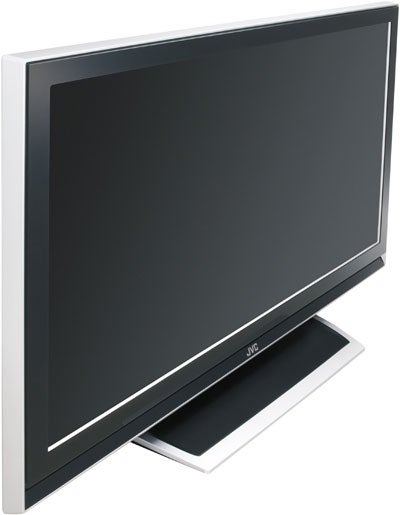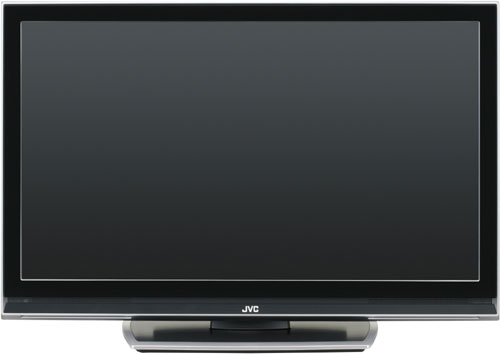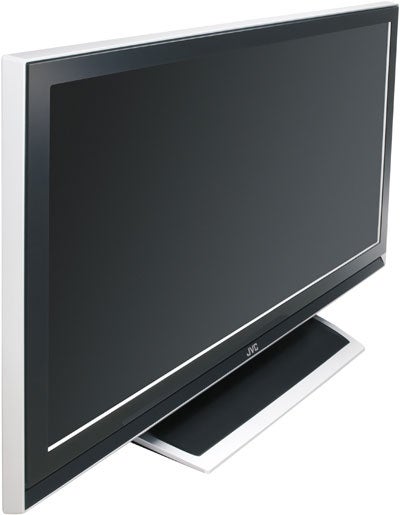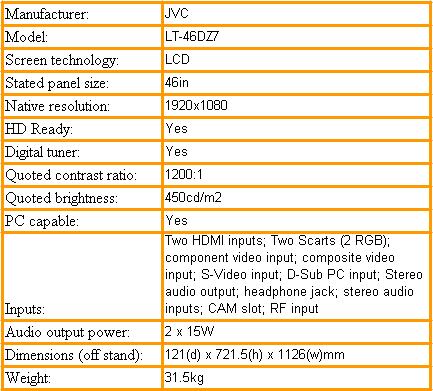JVC LT-46DZ7 46in LCD TV Review
JVC LT-46DZ7 46in LCD TV
Finally JVC has a Full HD offering, but was it worth the wait?

Verdict
Key Specifications
- Review Price: £1573.00
Well, it’s about time too. With every serious AV manufacturer falling over themselves to climb aboard the ‘full HD’ bandwagon, a full HD set from JVC is long overdue. But it’s finally here in the shape of the LT-46DZ7, a 46in set that proudly backs up its 1,920 x 1,080 pixel count with absolutely every last drop of JVC’s current TV processing technology.
We’ll come to that technology presently, but let’s start with how the set looks – namely, quite retro for such a cutting edge TV with its black bodywork and blue neon power light. But that’s certainly not to say we don’t like it.
Connections do almost all the HD necessaries, with twin HDMIs and a component video input. But surprisingly none of these HD jacks can take 1080p HD sources, instead topping out at 1080i. When we brought this to JVC’s attention the company was quick to point out that its screen does at least show pictures in 1080p, as onboard processing converts incoming signals to the 1080p format. But we know (since we’re among them!) that there are many AV purists out there who prefer TVs to offer the option of just taking in a ‘pure’ 1080p source and showing it without any deinterlacing processing.
There is some good news when it comes to HD ‘purity’, though, as we discover a mode that allows you to show 1,920 x 1,080 sources on an overscanning-free, pixel-for-pixel basis.
Other connections include a PC port, plus a CI slot for adding subscription channels to what’s obviously a built-in digital tuner.
And so to that picture processing technology we mentioned earlier. Subsumed under a ‘DynaPix HD’ umbrella name can be found a variety of different processing elements. Probably the single most important is JVC’s Digital Image Scaling Technology – or DIST for short. This, as its name suggests, is a sophisticated, all-digital scaling engine focussed on making any necessary image scaling look cleaner; adding extra fine detail to pictures, especially when the source is standard definition; and making the edges of contoured objects less jagged.
JVC’s blurb on this TV also stresses that the new version of DIST being used is housed on a single chip powered by a 32-bit CPU, meaning it should operate at the sort of speeds necessary to process even HD images in real time without leaving unwanted side effects like smearing or video noise.
DynaPix HD also hosts two types of noise reduction: standard and MPEG, the latter of which is designed to counter the blockiness that can afflict low quality digital broadcasts. What’s more, the TV separates out the brightness and colour information in a picture before applying its noise reduction techniques to make their workings more accurate.
The last element of DynaPix HD we want to touch on is something called Super Digipure. This continually analyses the incoming image to see how much inherent contrast it has, automatically ramping up the contrast if the image doesn’t appear to have enough, or toning the TV’s contrast down a little if the image is already highly contrasted.
Having just mentioned them, we might as well start our assessment of the 46DZ7’s picture quality with how well all its various picture processing elements work. With DIST, the answer is that it works supremely well. Standard definition looks much sharper than it does normally on a full HD TV, and crucially the extra detailing is added without seemingly adding significant amounts of noise or other yucky side effects. The noise reduction routines do their work well too, provided you don’t set them too high (for if you do they tend to make high definition pictures look too soft for comfort).
The only DynaPix HD element we have concerns about is Super Digipure. At anything other than the least potent of its various activity settings, it can make pictures look way too harsh and noisy – and even the lowest setting isn’t perfect. So if it were us, we’d leave the feature turned off.
In more general terms, the 46DZ7’s pictures veer between looking really quite sublime and looking slightly disappointing. When they’re sublime it tends to be with bright, colourful and largely static HD images, such as pretty much any daytime sequence in Brokeback Mountain recorded in HD from Sky. At such moments the TV delivers a knockout combination of immense clarity and fine detailing, outstandingly vibrant but also subtly blended colour tones, and enough brightness to give you retina damage.
So good are the detailing and colour blend talents we’ve described that there seems no doubt the TV is delivering on the promise of its full HD pixel count.
These core qualities of the JVC’s pictures also make it a great friend of such colourful, bright Xbox 360 HD gaming fare as Viva Pinata and Virtua Tennis.
Where the TV can look slightly disappointing is during darker scenes where there’s a lot of motion going on. During just such a scene in the superb Casino Royale Blu-ray transfer, where James Bond charges around a sinking Venetian building beating up bad guys, it’s impossible to ignore two key weaknesses in the JVC’s presentation. First, black levels aren’t all that deep (as we worried they might not be after seeing the set’s uninspiring claimed 1200:1 contrast ratio); a common LCD problem certainly, but one we’ve seen tackled more successfully by rival LCDs from Sony, and Philips, plus various plasma models.
Second, it would appear that the 46DZ7’s LCD response time isn’t the best, since there’s rather noticeable blurring over Bond’s rampaging fists and feet. This problem is exacerbated while watching the standard definition DVD version of the same scene.
A third more minor quibble apparent during dark scenes is that some colour tones don’t look 100 per cent authentic, possibly because there’s a slight bluish undertone to the screen’s attempts to render a true black colour.
The inconsistencies of the 46DZ7’s pictures are certainly not replicated with its sound. For even though its speakers look rather ineffectual thanks to an obvious attempt to ‘hide’ them in the TV’s design, they’re actually terrifically powerful and deliver the sort of frequency range, especially at the bass end, that most flat TVs can only dream about.
”’Verdict”’
JVC’s 46DZ7 full HD debut gets so many things right that we have no doubt the brand will one day – probably fairly soon – turn in a truly outstanding full HD TV. But for now there are just enough concerns about a couple of common LCD flaws to leave the 46DZ7 as a good TV rather than a great one.

How we test televisions
We test every TV we review thoroughly over an extended period of time. We use industry standard tests to compare features properly. We’ll always tell you what we find. We never, ever, accept money to review a product.
Trusted Score
Score in detail
-
Value 7
-
Image Quality 8
-
Sound Quality 10

